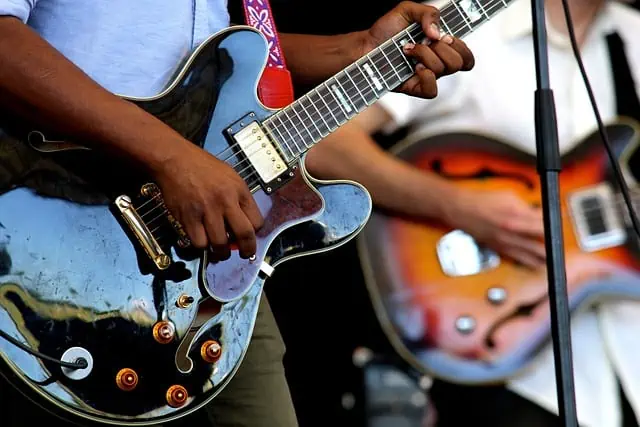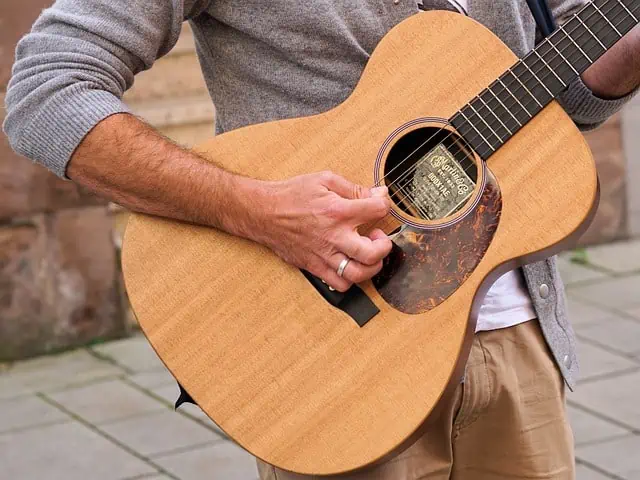You may have thought of the wood that guitars are made from only in terms of how to store and care for your guitar, or in terms of aesthetics. But did you know that wood actually has quite a bit of influence over the sound of acoustic guitars and hollow-body electrics? That’s why we call wood used to make guitars tonewoods.
To a lesser extent, they also impact the sound of semi-hollow body electrics. The effect is very small in solid-body electric guitars, with the pickups and strings having the biggest impact. But even then, if you have a very good ear, you may be able to hear the subtle differences caused by the wood in electric guitars where the only difference is the types of wood used in their construction.
Whether you simply want to understand why your current guitar sounds the way it does or you’re looking to buy a guitar, understanding the characteristics of tonewoods will be helpful.
Contents
How Guitars Produce Sound
It may be easier to understand how wood affects the tone if you understand how guitars produce sound. In essence, it’s vibrations. When you play the strings, they vibrate very fast. So fast that you can barely see it. But if you’ve ever watched a big instrument like a double bass being played in slow motion, you can clearly see the strings moving back and forth almost wildly. How that translates into something we can hear differs between acoustic and electric guitars.
Acoustic Guitars
With acoustic guitars, when you play the strings, their vibrations are sent into the saddle, then through to the sound board, and into the body of the guitar. I’m sure you will have noticed if you play an acoustic, that the whole body vibrates and the sound resonates from within. The sound hole then releases the sound so that we can hear it, although some of the sound travels through the body too.
The bigger the guitar, the louder and more resonant it is. Because lower frequencies (frequency is a measure of the pitch) have wider sound waves, you’ll also notice that guitars with larger bodies have more bass in their sound than smaller-bodied guitars. The waves are able to travel through bigger spaces better. It’s also why you hear bass through walls or from miles away. Bass frequencies travel further.
Electric Guitars
In hollow-body and semi-hollow body electric guitars, you’ll still get some of what I described above, just a lot more quietly and less bassy because of how thin these guitars are in comparison.
The primary mode that all types of electric guitars produce sound is electronically. The strings vibrate when you play, and the pickups, which are magnets, pick up those vibrations. Each magnet has coils around them. These coils move up and down generating a current that is sent through to the amp where the reverse happens, and we hear the sound coming out of the speakers.
You can now see why the impact of the tonewood is much bigger in acoustic guitars than in electric guitars which are more reliant on the strings and pickups.
How Wood Influences Sound
It all has to do with how heavy and dense the wood is and how different frequencies interact with the wood. You can also have two identical guitars made of the same type of wood, that sound different. This is because there are also differences in the grain of the wood. Whether it’s solid wood or laminate wood also affects the sound.
To get even more complex, wood changes over time. So your guitar may sound a little different over 5 years, and then again at 10, and so on. My guitar is 18 years old now. It doesn’t sound the same as it did when I first bought it. I noticed a definite change over the last few years. The environment that you keep your guitar in has an influence over what happens to the wood too, especially when it comes to humidity and temperature.
Solid Wood
Solid wood guitars generally offer more resonance since it vibrates better. The volume is also usually better than laminate guitars. Most, if not all, truly high-end guitars are solid wood guitars. This is because the wood is of better quality, and by nature, more expensive. You will be able to hear that a solid wood guitar usually sounds better than a laminate guitar.
Laminate Wood
Laminate wood means that thin strips of wood are glued together. This hampers the resonance and volume a little bit. A good option if you’re on a budget is to get a guitar with laminate sides and back, but a solid top.
Back and Side Construction
Wood used in the back and sides of the guitar amplify certain frequencies and eliminate others. They help to shape the overall sound.
Top
The top of the guitar is also called the sound board. It’s the part of the guitar that’s closest to the strings. As you know, the vibrations of the strings travel into the saddle and then into the sound board. It has the biggest influence on the sound of your guitar. This is why I recommend that the top of the guitar is solid wood.
Lacquer Matters Too
With well-made guitars, it’s a matter of preference whether you choose a satin-finish or glossy-finish. But when it comes to cheaply made guitars, if you go for glossy guitars, make sure the lacquer isn’t too thick. That’s because too much lacquer actually strangles the sound a bit as it affects the vibrations. You may lose some of the overtones too for the same reason.
The Influence of Various Tonewoods
The type of wood also makes a difference:
Mahogany
Mahogany is quite a stiff, dense wood. These characteristics give mahogany a dark, warm tone. Mids tend to stand out, although the highs and lows are present too. As the mahogany matures, it produces more overtones, giving the sound more complexity. Mahogany is typically used for the back and sides, but you will find a few guitars out there that also have mahogany tops.
Here’s an example of a mahogany guitar:
Spruce
Spruce is one of the most popular wood choices for tops. You’ll see varieties like Sitka, European a.k.a. Englemann, and Eastern Red a.k.a. Adirondack. Spruce is known for its consistent sound. It has very little complexity. While this sounds like a bad thing, it does mean that spruce is good for a variety of genres. The tone is crisp and loud, which sounds especially good on a steel-string. European spruce tends to be quieter as it’s softer, but it’s still louder than some of the other woods on this list.
Here’s an example of a spruce top guitar:
Koa
Koa is quite an expensive wood, and like a good whiskey, it takes time to truly come into its own. Still, as a wood favored for back and sides on high-end guitars, it still sounds pretty good if you enjoy a very bright sound. In time, it mellows to a warm, rich tone. Many feel it’s worth the wait. Once it’s mellow, Koa produces sparkly highs and darker lows. Initially, it’s best to play with your fingers, as using a pick will only emphasize the already overly bright tone.
Here’s an example of a koa guitar:
Rosewood
Rosewood is one of the more popular choices for backs and sides, especially for high-end guitars. Brazilian rosewood is especially hard to come by these days due to new laws, so Indian rosewood is becoming more popular. Rosewood has a rich, dark, complex resonance. It provides a clear sound and often a pretty balanced frequency response. In many cases, the highs and lows tend to shine more. Despite the dark resonance, the overall tone is bright.
Here’s an example of a guitar with rosewood sides:
Maple
Maple is more commonly used for the neck, but you will find guitars with maple back and sides, and some with maple tops too. The more common type is flamed-maple though you may find birdseye maple too. It’s known for its exceptional clarity and transparency when it comes to tone. There is zero to no complexity and the tone decays quickly. This distinct lack of sustain combined with the clear tone allows notes to be heard very well. Maple also has a bright tone with an emphasis on the mids and highs.
Here’s an example of a maple guitar:
Cedar
Cedar is also a very popular choice for guitar tops. It produces a warmer, darker tone with some complexity in the overtones. It’s best suited to fingerstyle guitar, because it tends to lose clarity when played loudly or with picks. Basically, it’s a wood best suited to more delicate playing. Overall, it’s a quieter wood, but makes up for that with great tone quality.
Here’s an example of a cedar guitar:
Walnut
Walnut is another wood that mellows with age. It starts with quite a bright tone and becomes darker and warmer as it ages. Even initially, however, it still has a warmer tone than koa. While it does shine more in the mid to high range, you will still have decent lows. If you’re someone who prefers boomy low-end, however, walnut isn’t for you. It’s generally used on backs and sides of guitars.
Here’s an example of a walnut guitar:
Sapele
Sapele has a tone similar to mahogany, but you’ll find more lows and highs. It has a warm tone that provides rich lows, emphasized mids, and sparkly highs. This makes it a very versatile wood. It sounds good no matter how you play. It’s generally used on the sides and backs, though you may find a few guitars with sapele tops too.
Here’s an example of a sapele guitar:
Alder
Alder is a lightweight wood that produces a more complex tone. It’s often been described as straddling the divide between bright and dark tone, and many find that it works well for a variety of genres. The upper mids and highs tend to shine with Alder, though overall, it has a balanced frequency response. It provides good clarity too. You can find Alder used as tops, backs, and sides.
Here’s an example of an alder top guitar:
Ash
There are two types of ash, hard ash, and soft ash, a.k.a. Swamp ash. Because of the difference between the two, they also sound different. Hard ash has a brighter tone with good sustain. Soft ash has less sustain, but the tone is warmer. Ash is used for tops, backs, and sides.
Here’s an example of an ash top guitar:
Basswood
Basswood is common on entry-level guitars because it’s a cheap wood compared to the other types of wood on this list. Having said that, you can find it on some high-end signature electric guitars too. It produces soft highs and emphasized mids and not much low-end. On the upside, the because it soften’s the highs, if you aren’t a fan of tinny sounding highs, basswood will serve you well. It’s used for tops, backs, and sides.
Here’s an example of a basswood body guitar
Poplar
Poplar sounds similar to alder, fairly balanced, but with perhaps slightly more emphasis in the mids. It lacks complexity that makes it work for different genres. However, it’s less articulate, with almost a muddy tone. It’s often seen in lower-end guitars, but there are high-end guitars that are made from poplar too. This is more the case for electric guitars.
Here’s an example of a poplar guitar:
Korina
Korina is typically harder to come by, difficult to work with, and more expensive, and so is found on higher-end guitars. It sounds similar to mahogany, having a warm tone. Korina, however, has a sweeter sounding midrange which makes it brighter than mahogany. It also supports low end very well and offers good sustain and clarity.
Here is an example of a korina guitar
Cherry
Occasionally, you may come across a guitar made from cherry, particularly on hollow-body electric guitars. It has a bright tone that’s crisp with good clarity. Cherry sounds similar to maple, but what sets it apart is the clarity.
I couldn’t find a guitar made out of cherry wood, but I did find this cherry wood
Okoume
Okoume sounds like mahogany, warm with a full frequency response. Aside from the color, the only difference really is that it’s cheaper.
Here’s an example of an okoume guitar
Pine
Pine is one of the rarer woods used. But when it is used, you can expect a warm, crisp tone with emphasized highs.
Here’s an example of a pine guitar
Laurel
Indian laurel is sometimes used for the backs and sides, but more for the fretboard. This is because It tends to be a very heavy, dense wood. Laurel provides beautiful complexity and a bright tone. The highs are sparkly and the lows punchy. Because of this tone quality, you can find guitars with laurel backs and sides.
Here’s an example of a guitar with a laurel fretboard:
Bubinga
Bubinga has very similar properties to rosewood, but with a brighter, albeit it still more on the darker side of things tone-wise. The mids tend to shine. You get excellent sustain with bubinga. It’s more commonly used for the necks, backs, and sides of guitars.
Here’s an example of a guitar with bubinga back and sides
Ovangkol
Ovangkol is one of the woods that are becoming popular due to sustainability. It has similarities to rosewood, but sounds a little brighter. Overall, you get good lows, mids, and clear highs, resulting in a full, warm tone. It resonates well, but it lacks some of the sustain that rosewood has.
Here’s an example of a guitar with ovangkol back and sides
Does the Type of Wood of the Neck and Fretboard Matter?
It does, but to a lesser extent than the body. Often you’ll see that the wood used for the neck is different from that of the body. In some cases, this is because the wood chosen for the body wouldn’t be able to handle the tension. Sometimes, it’s for the interesting tonal quality the mix will bring. The type of wood in the neck often also balances the tone.
What guitarists tend to pay more attention to, is how the neck, and particularly, how the fretboard feels. You want smooth but strong woods for this purpose. Playing on a guitar with a fretboard that isn’t smooth or where you can’t slide your hand smoothly up and down the neck is uncomfortable to say the least. It also affects how well you play.
Most of the time, however, even cheap guitars have smooth and strong woods for the neck and fretboard. It’s just those brands that are really rubbish that produce guitars with very shoddy craftsmanship when it comes to the wood.
So, you’re already aware of the tonal qualities of maple, mahogany, sapele, laurel, bubinga, and rosewood, which are common woods chosen to construct the neck of the guitar with. Rosewood is also one of the most popular choices for the fretboard, though you may find some guitars that use maple and walnut.
Here are some more woods that are mostly only seen used for the neck or fretboard.
Ebony
Ebony is a very hard, smooth wood with a dark color. You’ll usually see the African variety used, as the Asian variety has a striped appearance. It’s a common choice for the fretboard because of these characteristics. Ebony stays beautiful for many years. It has a quick response, a bright tone, and provides good sustain.
Here’s an example of a guitar with an ebony fretboard
Pau Ferro
Pau Ferro is similar to rosewood, but is harder, and provides a brighter, sharper tone with a faster attack. It feels smooth, which is why it’s used for the neck and the fretboard.
Here’s an example of a guitar with a pau ferro fretboard
Purpleheart
Purpleheart, a.k.a. Amaranth, is brown with deep purple tones. It’s used more in laminated form for the neck, usually in electric guitars (because it’s heavy), and as fretboards for both acoustics and electrics. The tone is balanced, clear with good sustain and complex overtones.
Here’s an example of a guitar with a purpleheart fretboard
Conclusion
Now you can make an informed decision when you shop for a guitar. If you’re a fan of natural wood, there are plenty of guitars out there that showcase the wood they’re made from beautifully. But there are the stained or painted options too. Most importantly, you can choose the sound you want. The best thing to do is to actually play a guitar at a store before buying. But when you’re looking online, understanding tonewoods will help you to make a good choice.
Happy jamming!

Cheanné Lombard lives in the home of one of the new Seven World Wonders, Cape Town, South Africa. She can’t go a day without listening to or making music.
Her love of music started when her grandparents gave her a guitar. It was a smaller version of the full-sized guitars fit for her little hands. Later came a keyboard and a few years after that, a beautiful dreadnought guitar and a violin too. While she is self-taught when it comes to the guitar, she had piano lessons as a child and is now taking violin lessons as an adult.
She has been playing guitar for over 15 years and enjoys a good jam session with her husband, also an avid guitarist. In fact, the way he played those jazzy, bluesy numbers that kindled the fire in her punk rock heart. Now she explores a variety of genres and plays in the church worship group too and with whoever else is up for a jam session.



